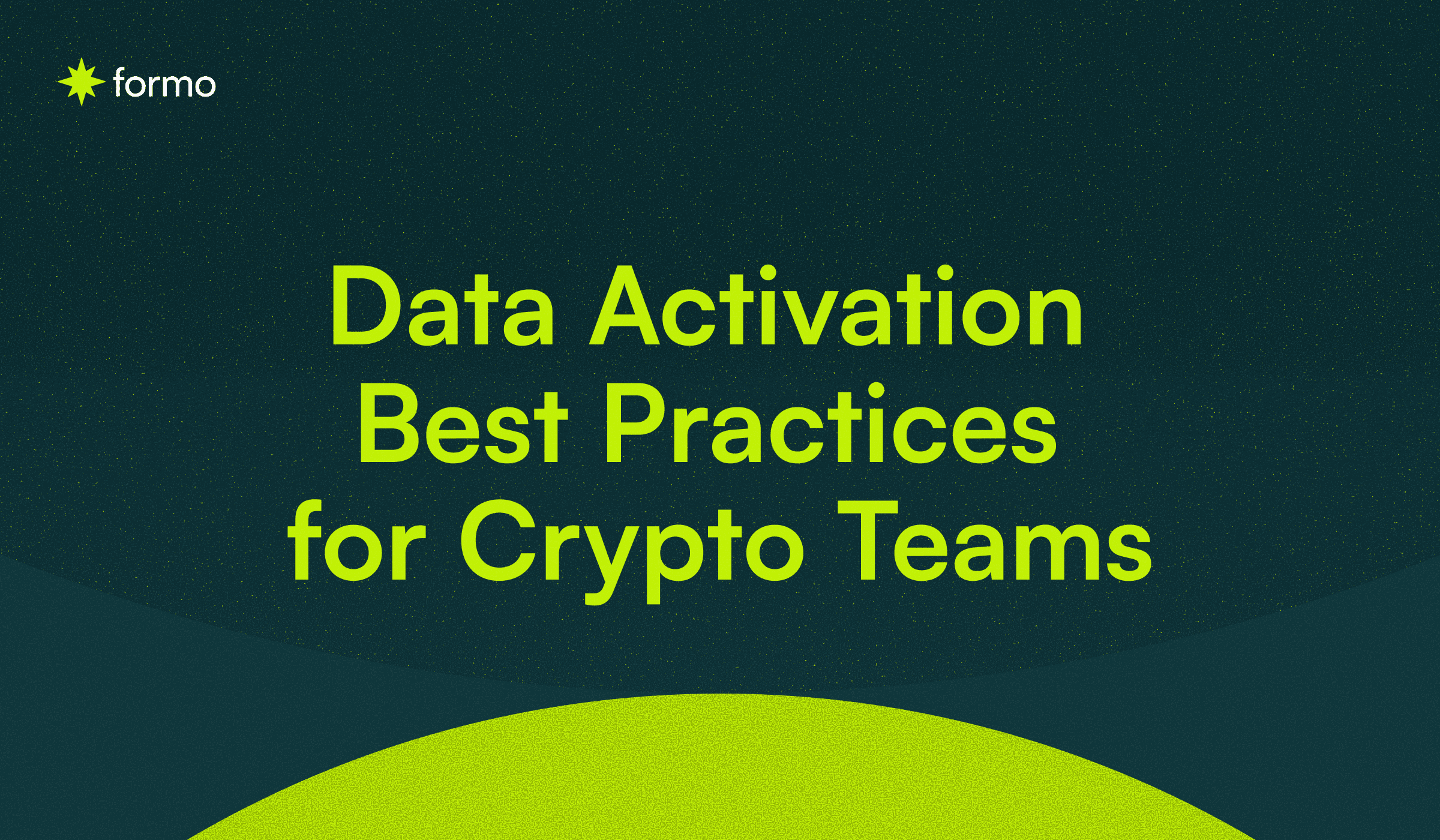For onchain builders, the core challenge is clear: acquiring and retaining users in a complex, evolving space. Many teams juggle multiple analytics tools, such as Google Analytics, Mixpanel, and Dune, yet struggle to gain a unified view of the user journey. Data is fragmented across social media, websites, and blockchains, making it nearly impossible to understand what truly drives growth.
The Web3 user lifecycle provides a powerful framework for addressing this challenge. It provides a structured way to understand and optimize the entire user journey, from their first interaction to becoming a loyal advocate. Segmenting users by their lifecycle stage (new, returning, churning, etc) allows web3 product and marketing teams to surgically target specific user groups with product features and growth tactics designed to activate them.
This guide will walk you through each stage of the Web3 customer lifecycle. We'll define each phase, explain how to analyze web3 user lifecycles using unified onchain and offchain data, and show how a platform like Formo provides the tools needed for you to drive sustainable growth onchain.
What is the Web3 User Lifecycle?
The Web3 user lifecycle is the sequence of stages a user experiences when interacting with a dApp or onchain project. It maps their journey from initial discovery to becoming a long-term, engaged community member.
While Web3 marketing shares similarities with the traditional Web2 marketing funnel, the Web3 user lifecycle has several key differences. The biggest challenge is that this data is fragmented. Traditional tools can't connect a marketing campaign on X to a specific transaction on-chain. Instead of just clicks and sign-ups, crypto incorporates wallets, blockchains, and smart contract transactions.
Web3 User Lifecycle Analytics is the process of tracking, analyzing, and optimizing the user's journey throughout their different stages in your onchain app using both onchain and offchain data.
Understanding the web3 user lifecycle allows your team to move beyond surface-level metrics and focus on the actions that generate real value and retention.
The 5 Stages of the Web3 Customer Lifecycle
To effectively drive growth onchain, you need to understand how users move through each stage. Here’s a breakdown of the five key web3 user lifecycle stages, including tactics and the metrics you should be tracking.
1. Discovery
This is how potential users first learn about your project. It’s the top of your funnel, where awareness is generated. Web3 marketing here is about increasing exposure and visibility.
Example: A user sees a viral thread on X (formerly Twitter) about your new DeFi protocol and clicks the link to your site.
Tactics:
Community Marketing: Engage with potential users on platforms like Discord, Telegram, and Farcaster.
Influencer Marketing: Partner with respected voices in the Web3 space to reach their audience.
Airdrops: Generate buzz and attract early adopters by distributing tokens to a targeted group of wallets.
Content Marketing: Publish insightful blog posts, in-depth guides, and viral threads that establish your expertise.
Paid Ads: Run targeted campaigns on crypto-native platforms to drive initial traffic.
Metrics to Track:
Social mentions
Referral traffic
Website visits
2. Onboarding
This is the first direct interaction a qualified lead has with your dApp. It’s where first impressions are made and a visitor becomes a new user. A seamless experience is critical.
Example: A user connects their wallet to your dApp for the first time, completes a sign-up quest to gain a role in your Discord, or fills out a token-gated form for beta access.
Tactics:
Implement simple and seamless wallet onboarding.
Provide guided tutorials or interactive walkthroughs.
Use clear calls-to-action that guide users to the next step.
Metrics to Track:
Wallet connect rate
New user sign-ups
Quest completions
New community members
3. Engagement
This is the point where users actively and repeatedly interact with your dApp’s core features. This stage helps you distinguish your power users from dormant users.
Example: A user returns weekly to stake tokens on your platform, consistently trades on your DEX, or actively participates in gameplay.
Tactics:
Gamification: Introduce points, badges, or leaderboards to encourage repeat usage.
Regular Product Updates: Ship new features that add value and keep the experience fresh.
Community Events: Host AMAs, trading competitions, or workshops to foster a sense of belonging.
Metrics to Track:
Daily/Weekly Active Users (DAU/WAU)
Transactions per wallet
Feature adoption rate
Session duration
4. Retention
This crucial stage focuses on ensuring users consistently return to your platform. It involves preventing active users from becoming dormant and reactivating those who have churned (resurrected users).
Example: A user who was previously inactive returns to the app after receiving a targeted notification about a new high-yield staking pool.
Tactics:
Loyalty Programs: Reward long-term users with exclusive benefits or token incentives.
Personalized Notifications: Send targeted alerts based on a user's wallet activity and past behavior.
Feedback Loops: Actively solicit and act on user feedback to show you value their input.
Metrics to Track:
Cohort retention rate
Churn rate
Resurrected user rate
User lifetime value (LTV)
5. Advocacy
This is when your most satisfied power users become organic promoters. They drive word-of-mouth growth and are your most valuable marketing asset.
Example: A DAO contributor shares a referral link with their community, bringing in 15 new, active users.
Tactics:
Referral Programs: Create programs with onchain rewards that are automatically distributed.
Ambassador Programs: Empower your most passionate users to represent your brand.
Encourage User-Generated Content: Feature and reward community-created content like tutorials or reviews.
Metrics to Track:
Number of referred wallets
Social media mentions from users
Community-led growth initiatives
Understanding the User Lifecycle Using Funnels
Funnels help you visualize how users successfully progress through the onboarding and activation process. The percentage of users moving from one stage to the next determines your effectiveness in activating users, while the size of the drop-offs highlights areas for potential improvement. The first step is to map lifecycle metrics by building relevant funnels and organizing them within a comprehensive dashboard.
The crypto growth funnel offers a high-level view of the onboarding and activation stages. Its primary purpose is to assess the proportion of users reaching meaningful engagement milestones while identifying the main points of friction. Optimizing this funnel can significantly enhance your acquisition ROI, making it a critical metric for most web3 and DeFi projects.
Funnel analytics offers you insight on growth and product bottlenecks in your onchain app:
Onboarding Performance: Examine how well users complete onboarding. With free-to-use apps, a 20-40% drop-off between app initiation and onboarding completion is common. If your drop-off exceeds 30%, consider refining your onboarding process to boost engagement. Addressing this stage is particularly impactful because higher drop-offs here ripple through the entire user lifecycle and hinder activation rates.
Leading to the “Aha” Moment: Your onboarding process must guide users to perform the core action as early as possible. A high drop-off between onboarding completion and the first core action often indicates poor communication of the app’s value, confusing next steps, or hidden frictions in the process. For example, if only 60% of users completing onboarding proceed to the activation stage, this is a red flag that requires immediate attention.
Establishing Engagement Targets: Define the optimal frequency of core actions necessary for strong user retention. Add steps to the funnel until additional repetitions show diminishing returns. This provides a clear target for user engagement, such as Facebook’s well-known “7 friends in 10 days” model. Use CRM campaigns strategically to guide users toward achieving these engagement milestones.
Optimizing Funnel Segmentation: Segment your funnel by attributes like geography, user persona, platform, or other relevant properties. Analyzing these segments reveals nuanced friction points and highlights areas where different audiences face distinct challenges. Targeted optimizations based on this data can lead to quicker and more impactful improvements.
By constructing and monitoring how your users traverse the funnel, your team can pinpoint areas of improvement and ultimately drive growth for your onchain app or protocol.
Use Cases for User Lifecycle Analysis in Web3 and DeFi
Understanding and optimizing user lifecycles in Web3 and DeFi apps is essential for product growth. With the right metrics, you can identify pain points and opportunities unique to decentralized platforms.
Below are example use cases of user lifecycle tracking for crypto product and marketing teams:
1. Onboarding to First Transaction
Track the time it takes for a new user to connect and make their first successful transaction (e.g., deposit, swap, borrow). Key questions to address might include:
Are users dropping off due to wallet issues or gas fees?
Is your onboarding experience intuitive for retail users?
Implement interactive tutorials and guides to answer frequently asked questions. Abstract out complexity using passkeys and embedded wallets to simplify onboarding.
2. Retention Analysis
Retention is critical for for onchain apps and protocols. Monitor user churn rates—from initial deposits to asset withdrawal—and identify triggers that lead to disengagement.
Why are users churning?
What features or factors makes users retain?
3. Feature Adoption
When introducing new features, track user engagement rates before and after the release. Metrics such as frequency of usage and changes in transaction volume will help you evaluate the impact of these features.
Roll out features gradually, listen to users, and refine based on real usage data.
4. Incentive Optimization
For DeFi apps with tokens, track user activity and measure how incentives influence impact on TVL, volumes, and fees. Are reward distributions driving consistent engagement and sustainable growth?
Identify patterns among highly active users and design the right incentive programs to drive participation among both active and passive users.
5. Segmenting Users by Lifecycle
Understand how users interact with your product over time. Lifecycle analysis groups users into segments based on their lifecycle stages like acquisition, activation, engagement, and retention. This helps Web3 and DeFi teams create targeted strategies based on user behaviors and engagement patterns.
For example, tailor onboarding for new users or personalize rewards for long-term users. Identify where users thrive or drop off.
Lifecycle analysis helps break down active users into:
New users
Retained users
Resurrected users
This deep dive into user lifecycles helps pinpoint growth opportunities, reduce churn, and optimize resources. Craft precise strategies that resonate with high-value segments, driving retention and transactional activity.
Best Practices for Tracking the User Lifecycle in Web3
Tracking the user lifecycle effectively is essential for driving growth and enhancing user retention. Here are the best practices to ensure you get comprehensive, actionable insights.
Define Key Stages Clearly: Break the user lifecycle into specific, measurable stages: awareness, acquisition, activation, retention, and advocacy. Ensure your team agrees on the definitions and the key performance indicators (KPIs) for each phase.
Leverage Onchain and Offchain Data: Combine onchain activity (transactions, wallet behavior) with offchain data (website analytics, social engagement) for a holistic view of the user journey. This unified approach provides deeper insights into user pain points and motivations.
Make Use of Onchain Attribution: Onchain attribution connects offchain marketing efforts directly to onchain actions, allowing you to measure the true ROI of your growth initiatives. By unifying offchain and onchain data into a single platform, you can replace complex, multi-tool setups and gain a clear view of your entire user lifecycle.
Implement Event Analytics: Use granular event analytics to monitor user activity as it happens. This allows you to quickly identify drop-off points and opportunities for product wins.
Gather Cross-Chain Data: As users operate across multiple networks, ensure your analytics can aggregate data from all relevant chains. This is critical for understanding user behavior in a multi-chain environment.
Track Wallet Journeys: Map the activity of individual wallets over time to understand key touchpoints and identify high-value users. This helps identify opportunities for targeted engagement.
Refine Metrics Regularly: Continuously evaluate the relevance of your metrics. As your product evolves, your KPIs should evolve with it. The early KPIs you used to reach PMF will be different from late-stage KPIs for growth and scaling.
Build Visual Dashboards: Use visual tools with graphs, charts, and heatmaps to communicate insights clearly to your entire team and stakeholders.
Automate Reporting: Set up automated reports for recurring metrics like user retention, wallet activity, and referral trends. This saves time and ensures consistent updates.
Feedback Loops: Gather qualitative feedback through surveys, interviews, and community discussions to complement your quantitative data and identify areas for improvement.
Transform Data into Impact
Mastering the Web3 user lifecycle is fundamental to building a successful and sustainable onchain business. It requires moving beyond fragmented data and adopting a unified analytics solution built for the unique challenges and opportunities of Web3.
By understanding how users discover, join, and interact with your project, you can make data-driven decisions that fuel growth.
Formo is designed to give onchain teams the clarity they need to grow.
Unified Analytics: Formo provides a single dashboard to track the entire user journey, from the first ad click to every onchain transaction. No more juggling Google Analytics and Dune.
Wallet Intelligence: Segment users into cohorts like "New Users," "Power Users," or "Dormant Users" based on wallet labels and onchain behavior. This allows for highly targeted retention campaigns.
Onchain Attribution: Measure the true ROI of your marketing campaigns by tracking which channels drive the most valuable onchain activity, not just clicks.
Real-Time Dashboards: Get immediate insights into user behavior, identify drop-off points, and make data-driven decisions without needing a dedicated data team or SQL knowledge.
Follow Formo on LinkedIn and Twitter, and join our community for more onchain growth insights.
Read more:
FAQs
What are the key stages of the Web3 customer lifecycle?
The Web3 customer lifecycle covers five essential stages:
Discovery: How users first find your project.
Onboarding: Their initial experience joining and setting up.
Engagement: Active interaction with your dApp or platform.
Retention: Keeping users active over time.
Advocacy: Users becoming promoters of your project.
Understanding these stages helps optimize the user journey from initial interest to loyal community member.
What is onchain attribution, and why is it important for Web3 marketing?
Onchain attribution connects your marketing efforts to actual blockchain actions. It links offchain activities (e.g., ads, social media posts) directly to onchain user behaviors (e.g., swaps, staking, NFT mints). This is crucial for:
Measuring true ROI: See which campaigns drive real value.
Optimizing spend: Allocate budget to the most effective channels.
Understanding user intent: Know what motivates users to act onchain.
It's the key to effective Web3 marketing analytics.
How can I track and reduce Web3 churn?
To track and reduce Web3 churned users:
Monitor cohort retention rates: Identify when users drop off.
Analyze onchain activity: Pinpoint inactivity patterns (e.g., token transfers out, no dApp interactions).
Implement targeted re-engagement: Use loyalty programs, governance participation incentives, and personalized notifications.
Gather feedback: Understand why users leave.
Event analytics tools like Formo help you identify at-risk users early.
What tools are best for Web3 user lifecycle analysis?
The best tools for Web3 user lifecycle analytics are those specifically built for Web3, offering unified onchain and offchain data capabilities.
Traditional tools (Mixpanel, Google Analytics) miss onchain actions.
Formo provides a unified solution, capturing both offchain and onchain data for a holistic view of the user journey.
How can I unify my onchain and offchain data for better Web3 analytics?
Unifying your data is critical for complete Web3 analytics.
Use crypto-native analytics: Use a solution like Formo that understands the full onchain user journey, from in-app activity on your dApp/website to onchain transactions.
Install SDKs: A simple SDK integration can link user profiles to their wallet addresses.
Success: Transform anonymous wallet addresses into rich onchain personas with full information on the user lifecycle.
This provides a single, clear view of the entire customer journey, powering smarter growth decisions.





